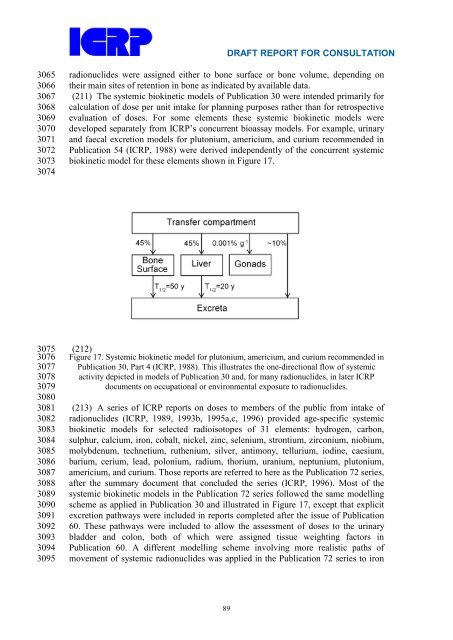Occupational Intakes of Radionuclides Part 1 - ICRP
Occupational Intakes of Radionuclides Part 1 - ICRP
Occupational Intakes of Radionuclides Part 1 - ICRP
Create successful ePaper yourself
Turn your PDF publications into a flip-book with our unique Google optimized e-Paper software.
3065<br />
3066<br />
3067<br />
3068<br />
3069<br />
3070<br />
3071<br />
3072<br />
3073<br />
3074<br />
3075<br />
3076<br />
3077<br />
3078<br />
3079<br />
3080<br />
3081<br />
3082<br />
3083<br />
3084<br />
3085<br />
3086<br />
3087<br />
3088<br />
3089<br />
3090<br />
3091<br />
3092<br />
3093<br />
3094<br />
3095<br />
DRAFT REPORT FOR CONSULTATION<br />
radionuclides were assigned either to bone surface or bone volume, depending on<br />
their main sites <strong>of</strong> retention in bone as indicated by available data.<br />
(211) The systemic biokinetic models <strong>of</strong> Publication 30 were intended primarily for<br />
calculation <strong>of</strong> dose per unit intake for planning purposes rather than for retrospective<br />
evaluation <strong>of</strong> doses. For some elements these systemic biokinetic models were<br />
developed separately from <strong>ICRP</strong>’s concurrent bioassay models. For example, urinary<br />
and faecal excretion models for plutonium, americium, and curium recommended in<br />
Publication 54 (<strong>ICRP</strong>, 1988) were derived independently <strong>of</strong> the concurrent systemic<br />
biokinetic model for these elements shown in Figure 17.<br />
(212)<br />
Figure 17. Systemic biokinetic model for plutonium, americium, and curium recommended in<br />
Publication 30, <strong>Part</strong> 4 (<strong>ICRP</strong>, 1988). This illustrates the one-directional flow <strong>of</strong> systemic<br />
activity depicted in models <strong>of</strong> Publication 30 and, for many radionuclides, in later <strong>ICRP</strong><br />
documents on occupational or environmental exposure to radionuclides.<br />
(213) A series <strong>of</strong> <strong>ICRP</strong> reports on doses to members <strong>of</strong> the public from intake <strong>of</strong><br />
radionuclides (<strong>ICRP</strong>, 1989, 1993b, 1995a,c, 1996) provided age-specific systemic<br />
biokinetic models for selected radioisotopes <strong>of</strong> 31 elements: hydrogen, carbon,<br />
sulphur, calcium, iron, cobalt, nickel, zinc, selenium, strontium, zirconium, niobium,<br />
molybdenum, technetium, ruthenium, silver, antimony, tellurium, iodine, caesium,<br />
barium, cerium, lead, polonium, radium, thorium, uranium, neptunium, plutonium,<br />
americium, and curium. Those reports are referred to here as the Publication 72 series,<br />
after the summary document that concluded the series (<strong>ICRP</strong>, 1996). Most <strong>of</strong> the<br />
systemic biokinetic models in the Publication 72 series followed the same modelling<br />
scheme as applied in Publication 30 and illustrated in Figure 17, except that explicit<br />
excretion pathways were included in reports completed after the issue <strong>of</strong> Publication<br />
60. These pathways were included to allow the assessment <strong>of</strong> doses to the urinary<br />
bladder and colon, both <strong>of</strong> which were assigned tissue weighting factors in<br />
Publication 60. A different modelling scheme involving more realistic paths <strong>of</strong><br />
movement <strong>of</strong> systemic radionuclides was applied in the Publication 72 series to iron<br />
89

















